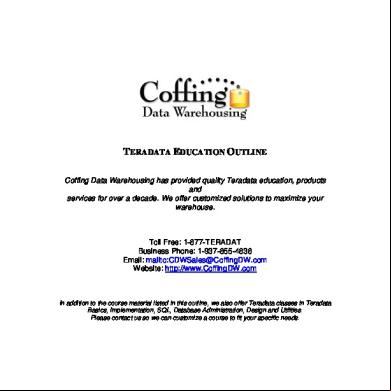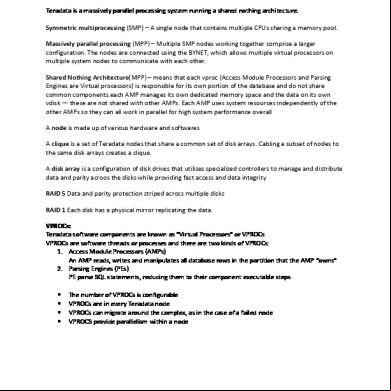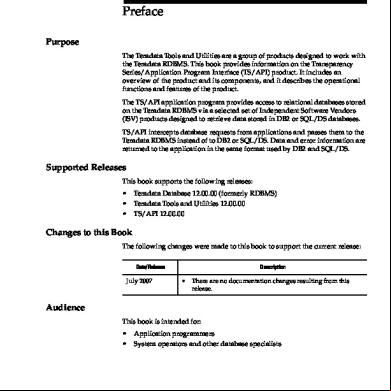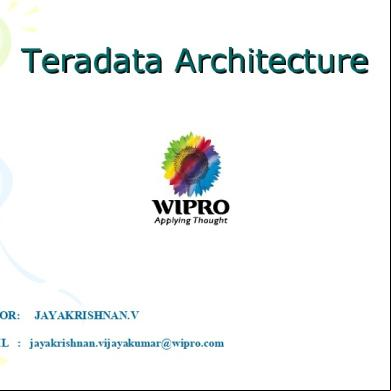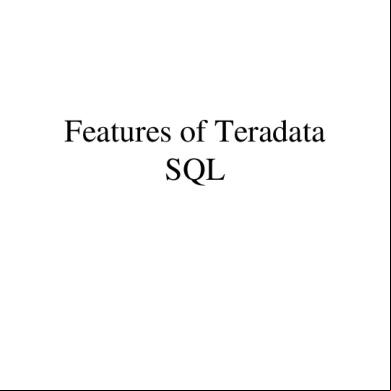Teradata Sql(tera Tom) 2s613v
This document was ed by and they confirmed that they have the permission to share it. If you are author or own the copyright of this book, please report to us by using this report form. Report 3b7i
Overview 3e4r5l
& View Teradata Sql(tera Tom) as PDF for free.
More details w3441
- Words: 1,769
- Pages: 11
Coffing Data Warehousing Education Outline 02/17/05
TERADATA EDUCATION OUTLINE Coffing Data Warehousing has provided quality Teradata education, products and services for over a decade. We offer customized solutions to maximize your warehouse.
Toll Free: 1-877-TERADAT Business Phone: 1-937-855-4838 Email: mailto:[email protected] Website: http://www.CoffingDW.com
In addition to the course material listed in this outline, we also offer Teradata classes in Teradata Basics, Implementation, SQL, Database istration, Design and Utilities. Please us so we can customize a course to fit your specific needs.
© 2006 Coffing Data Warehousing – All rights reserved. Confidential.
1
Coffing Data Warehousing Education Outline 02/17/05
PURPOSE Coffing Data Warehousing has been providing quality Teradata education for over a decade. We offer customized courses to maximize the effectiveness of each class. The purpose of this proposal is to build a lasting relationship with your company. To this end, we have combined our comprehensive Teradata education services in a unique package that we feel best suits the diverse needs of your company while offering our high quality product at competitive pricing. Coffing Data Warehousing is excited to offer you, our preferred partner, an innovative new way to look at training at the CoffingDW Teradata University (CDW-TU). This approach provides the ability to maximize learning potential. Our goal is to make your employees the most educated data warehouse experts in the industry. CURRICULUM: Coffing Data Warehousing will provide an experienced and highly qualified resource to deliver this customized educational seminar on the following topic(s): Teradata Education
• Teradata SQL COURSE DESCRIPTION
COURSE PREREQUISITES
There is no prerequisite for this course.
COURSE Duration/Format
This course is designed to be highly interactive with the audience.
COURSE AUDIENCE
The audience will consist of a mix of beginning,intermediate and advanced Teradata s. This course is designed to provide in-depth knowledge of Teradata SQL.
OBJECTIVES
© 2006 Coffing Data Warehousing – All rights reserved. Confidential.
2
Coffing Data Warehousing Education Outline 02/17/05
Tera-Tom on Teradata SQL for V2R6 Chapter 1 — The Rules of Data Warehousing Teradata Certification A Logical View of the Teradata Architecture The Parsing Engine (PE) The Parsing Engine in Detail The Parsing Engine Knows All The Access Module Processors (AMPs) The BYNET A Visual for Data Layout How Teradata handles Data Access The PE uses Statistics to come up with the Plan When there are NO Statistics Collected on a Table Teradata Understands SQL Teradata Maximums Teradata Maximums per Release Chapter 2 — SQL Basics Rows and Columns The SELECT Command The SELECT Command with * The WHERE Clause The Order BY Clause Sorting by Multiple Columns Sorting In Descending Order Chapter 3 — Teradata SQL Punctuation Valid Teradata Names Punctuation (Period .) How to SET your Default Database Punctuation (Comma ,) Punctuation (Single Quotes ‘ ‘) Punctuation (Double Quotes “ “) Punctuation - Placing Comments inside the SQL
© 2006 Coffing Data Warehousing – All rights reserved. Confidential.
3
Coffing Data Warehousing Education Outline 02/17/05
Chapter 4 - Help, Show, and Explain The HELP Command The HELP Command continued The SHOW Command The EXPLAIN Command Chapter 5 — SELECTING Rows Checking for NULL Values with IS NULL Checking for NULL Values with IS NOT NULL How will NULL Values Sort? The DISTINCT Command The DISTINCT Command with Multiple Columns Multiple DISTINCT statements in the same SQL The AND Operator The OR Operator The NOT Operator Order of Precedence for (), NOT, AND, or OR USING an IN List instead of OR The BETWEEN Operator The LIKE Operator and Percent Wildcard The LIKE Operator - Underscore Wildcard _ SQL that causes a Full Table Scan (FTS) Chapter 6 — Aggregates The Five Aggregates Aggregate Example with NULL Values Aggregate Example Answers Aggregates and the GROUP BY Statement Non-Aggregates must be Grouped Aggregates and the HAVING Statement WHERE, GROUP BY and HAVING Together Aggregates Query Results when a Table is Empty Chapter 7 — Subqueries
© 2006 Coffing Data Warehousing – All rights reserved. Confidential.
4
Coffing Data Warehousing Education Outline 02/17/05
The IN Statement (for review) Normal Subqueries Normal Subqueries using Multiple Tables Subqueries using Multiple Tables Continued Subqueries use values from the same Domain Using Subqueries with Aggregates Correlated Subquery How a Correlated Subquery runs EXISTS Estimate the Number of Rows for each Query Number of Rows Returned Quiz answers NOT IN Returns Nothing when NULLS are Present NOT EXISTS Vs NOT IN Chapter 8 – s Primary Key/Foreign Key Relationships Primary Key/Foreign Key Relationships A using Teradata Syntax A using ANSI Syntax A LEFT OUTER A LEFT OUTER (Continued) A Series of s (Inner) A Series of s (LEFT OUTER) A Series of s (RIGHT OUTER) A Series of s (FULL OUTER) Types vs. Strategies The Key Things about Teradata and s s need the ed rows to be on the same AMP Another Great Picture ing Tables with matching rows on different AMPs Redistributing a Table for Purposes Big Table Small Table Strategy Big Table Small Table Duplication Nested Hash Exclusion Product s Cartesian Product © 2006 Coffing Data Warehousing – All rights reserved. Confidential.
5
Coffing Data Warehousing Education Outline 02/17/05
Cross Self Adding Residual Conditions to a Adding Residual Conditions to a (AND) Chapter 9 – Aliasing, Title, Cast, and Format Title Function Title Function in BTEQ adds functionality Title Function used with Distinct Teradata Data Types CAST Function CAST Examples CAST Examples that FAIL Derived Columns Using and ALIAS on a Column Formatting a Column Trick to make ODBC use the FORMAT command FORMAT Options for Dates FORMAT Separators TIME FORMAT Options Date, Time, and Timestamp FORMAT Examples Chapter 10 – Interrogating Data SUBSTRING SUBSTR Concatenation of Character Strings Using SUBSTRING and Concatenation Together CHARACTER Vs VARCHAR The TRIM Function CHARACTERS Command Output Results for Multiple Commands Mixed The POSITION Function The INDEX Function SUBSTRING and POSITION Together COALESCE COALESCE with Literals ZEROIFNULL © 2006 Coffing Data Warehousing – All rights reserved. Confidential.
6
Coffing Data Warehousing Education Outline 02/17/05
NULLIFZERO NULLIF Command The CASE Command (Valued CASE) The CASE Command (Searched CASE) Nested CASE Statement Chapter 11 – Temporary Tables Derived Tables Derived Tables Derived Tables Continued Multiple Columns in a Derived Table Derived Table using with a Different Format Volatile Table Volatile Table Restrictions Global Temporary Tables Chapter 12 — SET Operators INTERSECT INTERSECT Example UNION UNION with INSERT SELECT to Eliminate Transient Journal EXCEPT or MINUS Chapter 13 — Views View Basics How to CREATE a View You SELECT from a View Change a View with the Keyword REPLACE Drop View Placing Aggregates inside a View Using “Locking for Access” in Views You can UPDATE Tables through Views Restricting UPDATE rows WITH CHECK OPTION Chapter 14 — Macros
© 2006 Coffing Data Warehousing – All rights reserved. Confidential.
7
Coffing Data Warehousing Education Outline 02/17/05
Macro Basics How to CREATE a Macro How to EXECute a Macro How to CREATE a Macro with Input Parameters How to change a Macro Drop Macro Macros that will not work Chapter 15 – Dates and Times RESERVED Words such as DATE and TIME How Dates are Stored on Disk How Teradata Displays the Date How to change the DATEFORM Teradata Dates stored as Integers for a Reason ADD_MONTHS Command EXTRACT Command with Dates EXTRACT Command with TIME The System Calendar Using the System Calendar for Date Comparison INTERVAL Processing for Arithmetic and Conversion INTERVAL Processing that Fails INTERVAL Arithmetic with Date and Time TIMESTAMP CURRENT_TIMESTAMP Chapter 16 – Creating Tables A Simple CREATE Statement A Simple INSERT Statement CREATING SET TABLES CREATING MULTISET TABLES UNIQUE PRIMARY INDEX A Quick Way to Copy Tables CREATE Table Options Defining Constraints at the Column Level Defining Constraints at the Table Level Partitioned Primary Index Tables Partitions can eliminate full table scans © 2006 Coffing Data Warehousing – All rights reserved. Confidential.
8
Coffing Data Warehousing Education Outline 02/17/05
Partitioning with CASE_N Partitioning with RANGE_N NO CASE, NO RANGE, or UNKNOWN Chapter 17 – WITH and WITH BY for Totals and Subtotals The WITH Statement The WITH BY Statement Combining WITH BY and WITH Combining Multiple WITH BY statements and WITH Combining Multiple WITH BY statements and WITH (Continued) Chapter 18 – Sampling Random Sampling – Number of Rows Sample Random Sampling – Percentage of the Table Sample Multiple Samples SAMPLE WITH REPLACEMENT SAMPLE SAMPLE WITH REPLACEMENT and RANDOMIZED ALLOCATION together SAMPLE with Conditional Test using WHEN SAMPLE example that Errors Chapter 19 – Rank and Quantile RANK RANK in ASC Order QUALIFY RANK is like a HAVING Statement QUALIFY RANK with a GROUP BY QUANTILE Function QUANTILE Function Example using 5 QUANTILE Function using 100 (Percentile) QUANTILE Function sorted ASC QUANTILE Function with Percentile (100) Chapter 20 – OLAP Cumulative Sum (CSUM) © 2006 Coffing Data Warehousing – All rights reserved. Confidential.
9
Coffing Data Warehousing Education Outline 02/17/05
Cumulative Sum (CSUM) Cumulative Sum (CSUM) with Multiple Sort Keys Cumulative Sum (CSUM) with GROUP BY CSUM to Generate Sequential Numbers CSUM using ANSI SUM OVER ANSI SUM OVER with PARTITION BY for Grouping Moving Sum (MSUM) Moving Sum (MSUM) with Multiple Sort Keys Moving Sum (MSUM) with GROUP BY Moving Sum (MSUM) with ANSI SUM OVER MSUM with ANSI SUM OVER and PARTITION BY for Grouping Moving Average (MAVG) Moving Average (MAVG) with Multiple Sort Keys Moving Average (MAVG) with GROUP BY MAVG with ANSI AVG OVER MAVG with ANSI AVG OVER and PARTITION BY for Grouping Moving Difference (MDIFF) Moving Difference (MDIFF) with Multiple Sort Keys Moving Difference (MDIFF) with GROUP BY Chapter 21 – New V2R5.1 and V2R6 Features New GROUP BY specifications Original GROUP BY Example GROUPING SETS CUBE ROLLUP TOP Rows Option QUEUE Tables FROM TABLE UDF Tables Chapter 22 – Miscellaneous Single Row MERGE INTO Command Single Row MERGE INTO Command Compression Implementing Compression How Compression Works Teradata and ANSI Mode © 2006 Coffing Data Warehousing – All rights reserved. Confidential.
10
Coffing Data Warehousing Education Outline 02/17/05
Teradata Mode Transactions (Called BTET) ANSI Mode Transactions SQRT Function INSERT/SELECT on two exact tables. INSERT/SELECT on Tables that Don’t Match Triggers Row Triggers or Statement Triggers Trigger Examples ORDERING Multiple Triggers in a Sequence Trigger Enable or Disable with ALTER Trigger Trigger Enable or Disable with ALTER Trigger Chapter 23 – Stored Procedures Stored Procedures CREATE Procedure Nesting BEGIN and END Statements ing a Stored Procedure Parameters An Example of all Three Parameters DECLARE and SET ELSEIF for Speed The Scoop is the LOOP and it LEAVES like a Tree The WHILE and END WHILE
© 2006 Coffing Data Warehousing – All rights reserved. Confidential.
11
TERADATA EDUCATION OUTLINE Coffing Data Warehousing has provided quality Teradata education, products and services for over a decade. We offer customized solutions to maximize your warehouse.
Toll Free: 1-877-TERADAT Business Phone: 1-937-855-4838 Email: mailto:[email protected] Website: http://www.CoffingDW.com
In addition to the course material listed in this outline, we also offer Teradata classes in Teradata Basics, Implementation, SQL, Database istration, Design and Utilities. Please us so we can customize a course to fit your specific needs.
© 2006 Coffing Data Warehousing – All rights reserved. Confidential.
1
Coffing Data Warehousing Education Outline 02/17/05
PURPOSE Coffing Data Warehousing has been providing quality Teradata education for over a decade. We offer customized courses to maximize the effectiveness of each class. The purpose of this proposal is to build a lasting relationship with your company. To this end, we have combined our comprehensive Teradata education services in a unique package that we feel best suits the diverse needs of your company while offering our high quality product at competitive pricing. Coffing Data Warehousing is excited to offer you, our preferred partner, an innovative new way to look at training at the CoffingDW Teradata University (CDW-TU). This approach provides the ability to maximize learning potential. Our goal is to make your employees the most educated data warehouse experts in the industry. CURRICULUM: Coffing Data Warehousing will provide an experienced and highly qualified resource to deliver this customized educational seminar on the following topic(s): Teradata Education
• Teradata SQL COURSE DESCRIPTION
COURSE PREREQUISITES
There is no prerequisite for this course.
COURSE Duration/Format
This course is designed to be highly interactive with the audience.
COURSE AUDIENCE
The audience will consist of a mix of beginning,intermediate and advanced Teradata s. This course is designed to provide in-depth knowledge of Teradata SQL.
OBJECTIVES
© 2006 Coffing Data Warehousing – All rights reserved. Confidential.
2
Coffing Data Warehousing Education Outline 02/17/05
Tera-Tom on Teradata SQL for V2R6 Chapter 1 — The Rules of Data Warehousing Teradata Certification A Logical View of the Teradata Architecture The Parsing Engine (PE) The Parsing Engine in Detail The Parsing Engine Knows All The Access Module Processors (AMPs) The BYNET A Visual for Data Layout How Teradata handles Data Access The PE uses Statistics to come up with the Plan When there are NO Statistics Collected on a Table Teradata Understands SQL Teradata Maximums Teradata Maximums per Release Chapter 2 — SQL Basics Rows and Columns The SELECT Command The SELECT Command with * The WHERE Clause The Order BY Clause Sorting by Multiple Columns Sorting In Descending Order Chapter 3 — Teradata SQL Punctuation Valid Teradata Names Punctuation (Period .) How to SET your Default Database Punctuation (Comma ,) Punctuation (Single Quotes ‘ ‘) Punctuation (Double Quotes “ “) Punctuation - Placing Comments inside the SQL
© 2006 Coffing Data Warehousing – All rights reserved. Confidential.
3
Coffing Data Warehousing Education Outline 02/17/05
Chapter 4 - Help, Show, and Explain The HELP Command The HELP Command continued The SHOW Command The EXPLAIN Command Chapter 5 — SELECTING Rows Checking for NULL Values with IS NULL Checking for NULL Values with IS NOT NULL How will NULL Values Sort? The DISTINCT Command The DISTINCT Command with Multiple Columns Multiple DISTINCT statements in the same SQL The AND Operator The OR Operator The NOT Operator Order of Precedence for (), NOT, AND, or OR USING an IN List instead of OR The BETWEEN Operator The LIKE Operator and Percent Wildcard The LIKE Operator - Underscore Wildcard _ SQL that causes a Full Table Scan (FTS) Chapter 6 — Aggregates The Five Aggregates Aggregate Example with NULL Values Aggregate Example Answers Aggregates and the GROUP BY Statement Non-Aggregates must be Grouped Aggregates and the HAVING Statement WHERE, GROUP BY and HAVING Together Aggregates Query Results when a Table is Empty Chapter 7 — Subqueries
© 2006 Coffing Data Warehousing – All rights reserved. Confidential.
4
Coffing Data Warehousing Education Outline 02/17/05
The IN Statement (for review) Normal Subqueries Normal Subqueries using Multiple Tables Subqueries using Multiple Tables Continued Subqueries use values from the same Domain Using Subqueries with Aggregates Correlated Subquery How a Correlated Subquery runs EXISTS Estimate the Number of Rows for each Query Number of Rows Returned Quiz answers NOT IN Returns Nothing when NULLS are Present NOT EXISTS Vs NOT IN Chapter 8 – s Primary Key/Foreign Key Relationships Primary Key/Foreign Key Relationships A using Teradata Syntax A using ANSI Syntax A LEFT OUTER A LEFT OUTER (Continued) A Series of s (Inner) A Series of s (LEFT OUTER) A Series of s (RIGHT OUTER) A Series of s (FULL OUTER) Types vs. Strategies The Key Things about Teradata and s s need the ed rows to be on the same AMP Another Great Picture ing Tables with matching rows on different AMPs Redistributing a Table for Purposes Big Table Small Table Strategy Big Table Small Table Duplication Nested Hash Exclusion Product s Cartesian Product © 2006 Coffing Data Warehousing – All rights reserved. Confidential.
5
Coffing Data Warehousing Education Outline 02/17/05
Cross Self Adding Residual Conditions to a Adding Residual Conditions to a (AND) Chapter 9 – Aliasing, Title, Cast, and Format Title Function Title Function in BTEQ adds functionality Title Function used with Distinct Teradata Data Types CAST Function CAST Examples CAST Examples that FAIL Derived Columns Using and ALIAS on a Column Formatting a Column Trick to make ODBC use the FORMAT command FORMAT Options for Dates FORMAT Separators TIME FORMAT Options Date, Time, and Timestamp FORMAT Examples Chapter 10 – Interrogating Data SUBSTRING SUBSTR Concatenation of Character Strings Using SUBSTRING and Concatenation Together CHARACTER Vs VARCHAR The TRIM Function CHARACTERS Command Output Results for Multiple Commands Mixed The POSITION Function The INDEX Function SUBSTRING and POSITION Together COALESCE COALESCE with Literals ZEROIFNULL © 2006 Coffing Data Warehousing – All rights reserved. Confidential.
6
Coffing Data Warehousing Education Outline 02/17/05
NULLIFZERO NULLIF Command The CASE Command (Valued CASE) The CASE Command (Searched CASE) Nested CASE Statement Chapter 11 – Temporary Tables Derived Tables Derived Tables Derived Tables Continued Multiple Columns in a Derived Table Derived Table using with a Different Format Volatile Table Volatile Table Restrictions Global Temporary Tables Chapter 12 — SET Operators INTERSECT INTERSECT Example UNION UNION with INSERT SELECT to Eliminate Transient Journal EXCEPT or MINUS Chapter 13 — Views View Basics How to CREATE a View You SELECT from a View Change a View with the Keyword REPLACE Drop View Placing Aggregates inside a View Using “Locking for Access” in Views You can UPDATE Tables through Views Restricting UPDATE rows WITH CHECK OPTION Chapter 14 — Macros
© 2006 Coffing Data Warehousing – All rights reserved. Confidential.
7
Coffing Data Warehousing Education Outline 02/17/05
Macro Basics How to CREATE a Macro How to EXECute a Macro How to CREATE a Macro with Input Parameters How to change a Macro Drop Macro Macros that will not work Chapter 15 – Dates and Times RESERVED Words such as DATE and TIME How Dates are Stored on Disk How Teradata Displays the Date How to change the DATEFORM Teradata Dates stored as Integers for a Reason ADD_MONTHS Command EXTRACT Command with Dates EXTRACT Command with TIME The System Calendar Using the System Calendar for Date Comparison INTERVAL Processing for Arithmetic and Conversion INTERVAL Processing that Fails INTERVAL Arithmetic with Date and Time TIMESTAMP CURRENT_TIMESTAMP Chapter 16 – Creating Tables A Simple CREATE Statement A Simple INSERT Statement CREATING SET TABLES CREATING MULTISET TABLES UNIQUE PRIMARY INDEX A Quick Way to Copy Tables CREATE Table Options Defining Constraints at the Column Level Defining Constraints at the Table Level Partitioned Primary Index Tables Partitions can eliminate full table scans © 2006 Coffing Data Warehousing – All rights reserved. Confidential.
8
Coffing Data Warehousing Education Outline 02/17/05
Partitioning with CASE_N Partitioning with RANGE_N NO CASE, NO RANGE, or UNKNOWN Chapter 17 – WITH and WITH BY for Totals and Subtotals The WITH Statement The WITH BY Statement Combining WITH BY and WITH Combining Multiple WITH BY statements and WITH Combining Multiple WITH BY statements and WITH (Continued) Chapter 18 – Sampling Random Sampling – Number of Rows Sample Random Sampling – Percentage of the Table Sample Multiple Samples SAMPLE WITH REPLACEMENT SAMPLE SAMPLE WITH REPLACEMENT and RANDOMIZED ALLOCATION together SAMPLE with Conditional Test using WHEN SAMPLE example that Errors Chapter 19 – Rank and Quantile RANK RANK in ASC Order QUALIFY RANK is like a HAVING Statement QUALIFY RANK with a GROUP BY QUANTILE Function QUANTILE Function Example using 5 QUANTILE Function using 100 (Percentile) QUANTILE Function sorted ASC QUANTILE Function with Percentile (100) Chapter 20 – OLAP Cumulative Sum (CSUM) © 2006 Coffing Data Warehousing – All rights reserved. Confidential.
9
Coffing Data Warehousing Education Outline 02/17/05
Cumulative Sum (CSUM) Cumulative Sum (CSUM) with Multiple Sort Keys Cumulative Sum (CSUM) with GROUP BY CSUM to Generate Sequential Numbers CSUM using ANSI SUM OVER ANSI SUM OVER with PARTITION BY for Grouping Moving Sum (MSUM) Moving Sum (MSUM) with Multiple Sort Keys Moving Sum (MSUM) with GROUP BY Moving Sum (MSUM) with ANSI SUM OVER MSUM with ANSI SUM OVER and PARTITION BY for Grouping Moving Average (MAVG) Moving Average (MAVG) with Multiple Sort Keys Moving Average (MAVG) with GROUP BY MAVG with ANSI AVG OVER MAVG with ANSI AVG OVER and PARTITION BY for Grouping Moving Difference (MDIFF) Moving Difference (MDIFF) with Multiple Sort Keys Moving Difference (MDIFF) with GROUP BY Chapter 21 – New V2R5.1 and V2R6 Features New GROUP BY specifications Original GROUP BY Example GROUPING SETS CUBE ROLLUP TOP Rows Option QUEUE Tables FROM TABLE UDF Tables Chapter 22 – Miscellaneous Single Row MERGE INTO Command Single Row MERGE INTO Command Compression Implementing Compression How Compression Works Teradata and ANSI Mode © 2006 Coffing Data Warehousing – All rights reserved. Confidential.
10
Coffing Data Warehousing Education Outline 02/17/05
Teradata Mode Transactions (Called BTET) ANSI Mode Transactions SQRT Function INSERT/SELECT on two exact tables. INSERT/SELECT on Tables that Don’t Match Triggers Row Triggers or Statement Triggers Trigger Examples ORDERING Multiple Triggers in a Sequence Trigger Enable or Disable with ALTER Trigger Trigger Enable or Disable with ALTER Trigger Chapter 23 – Stored Procedures Stored Procedures CREATE Procedure Nesting BEGIN and END Statements ing a Stored Procedure Parameters An Example of all Three Parameters DECLARE and SET ELSEIF for Speed The Scoop is the LOOP and it LEAVES like a Tree The WHILE and END WHILE
© 2006 Coffing Data Warehousing – All rights reserved. Confidential.
11
